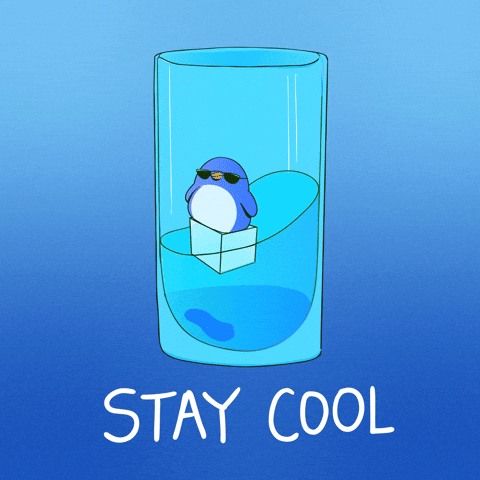Chill Out: 3 Self-Soothing Practices to Beat the Summer Heat
Wow– it’s been a hot summer so far! These unbearable heat waves impact us beyond having flushed cheeks, sweaty brows, and sunburnt skin– they influence our mental health too. Extreme heat can cause increased irritability, anger, distress, impulsivity, and exhaustion (Shalchi, 2023) (Pappas, 2024). High temperatures leave us vulnerable to experiencing symptoms, engaging in behaviors, and sitting in feelings that wreak havoc on our well-being (Pappas, 2024). If you’ve been struggling this summer, you’re not alone. Your mind and body are likely in need of some additional tactics and techniques to help you chill out.
3 Self-Soothing Practices to Beat the Summer Heat:
Cool your temperature
From Dialectical Behavior Therapy comes a distress tolerance skill that incorporates the power of changing our temperature to soothe our minds and bodies (Linehan, 2015). We can cool our temperature by touching something icy or cold to activate our parasympathetic nervous system which soothes physical and emotional distress caused by extreme heat (Linehan, 2015).
Ideas for cooling your temperature:
Grab an ice pack and place it on your neck or chest as a cold compress
Run cold water over your hands
Splash cool water on your face
Drink an icy cold or frozen beverage
Submerge your face in a bowl of ice water
Hop in an ice bath or cold tub
*Note: For those with a history of heart problems or other medical conditions, please consult your medical provider before engaging in these strategies as temperature change does affect heart rate. (Linehan, 2015).
Soothe your senses
Soothing through our senses can regulate our nervous systems by grounding us back in the present. This practice offers the tender care we need when our senses are overwhelmed by hot, humid temperatures. We can use sensory input to bring us back to baseline and simmer down.
Ideas for soothing your senses:
Sight: look at pictures of the snow; watch a live stream of the ocean; visit a pool; observe nature in the early morning; watch the sunset; go people-watching in air-conditioning
Smell: take a cool shower using your favorite soaps; put essential oils on your temples and wrist; visit a coffee shop or ice cream parlor and notice the aroma
Sound: listen to a chill playlist; pull up a soundtrack of the ocean or another moving body of water; observe the sounds of a cool rainstorm; notice the commotion of your ice-maker
Touch: hold an ice pack; feel the air-conditioning; sit outside and observe the breeze; take a cold shower or bath; drive with the windows open; sit in front of a fan
Taste: eat ice cream or a snow cone; drink cold lemonade or iced tea; enjoy your favorite sour candy; snack on an ice cube; eat a mint-flavored treat
Move your body: go for a swim; walk during the cooler hours of the day; do an online yoga or stretching class; take a bike ride; do some evening gardening
Mitigate with mindfulness
If a more reflective practice is your jam, you can also cool off by practicing mindfulness to bring your mind and body back to the here and now. Mindfulness is intentionally being in the present moment, without attaching or judging, and simply noticing our experiences (Linehan, 2015). Mindfulness can help reduce suffering, increase control, and enhance our present awareness (Linehan, 2015).
Ideas for mitigating with mindfulness:
Imagine icy imagery- You can use imagery by calling to mind a cold place (or maybe just cooler than your current environment). Bring that image to the forefront of your mind. Notice where you are and what you’re feeling, smelling, tasting, seeing, and touching. Let yourself sit and enjoy that place for a 2-3 minute timer.
Paced breathing- Another way to “cool down” is by slowing down your inhales and exhales and breathing deeply through your diaphragm. To practice paced breathing, your exhales should be longer than your inhales. Go through 5 cycles of breathing IN for 3 seconds and OUT for 5 seconds (or whatever pace works best for you!).
Observe other sensory input- When our tactile senses are overwhelmed by heat, check in with another sense. For instance, instead of fixating on what you’re feeling, direct your attention to what you’re seeing, hearing, smelling, or tasting. As your mind and/or body pull you back towards your tactile sensations, simply re-direct your attention to another experience (ex. listening to the band on a hot, summer day; smelling great food at the summer fair; sipping on your favorite ice-cold drink on the scorching beach, etc.)
The heat takes a toll on us– mind and body. Leaving us vulnerable to feeling and acting in ways that may not align with our intentions and values.
Hopefully, this post offered some ideas to beat the heat this summer. Don’t be afraid to be flexible in finding what works for you!
Stay cool and chill out there.
References
Linehan, M. M. (2015). DBT Skills Training Handouts and Worksheets (2nd ed.). New York, NY: The Guilford Press.
Linehan, M. M. (2015). DBT Skills Training Manual (2nd ed.). New York, NY: The Guilford Press.
Pappas, S. (2024, June 1). How heat affects the mind. Monitor on Psychology, 55(4), p. 42. Retrieved from https://www.apa.org/monitor/2024/06/heat-affects-mental-health
Shalchi, H. (2023, July 24). Excessive heat and its impact on mental health. Retrieved from Baylor College of Medicine: https://www.bcm.edu/news/excessive-heat-and-its-impact-on-mental-health


